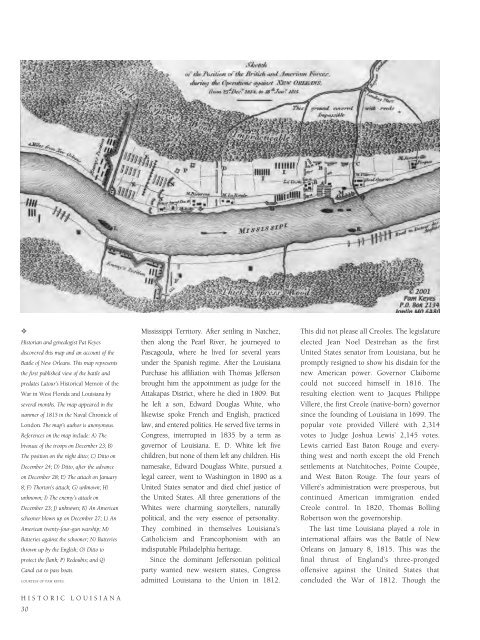Historic Louisiana
An illustrated history of Louisiana, paired with the histories of companies, families and organizations that make the state great.
An illustrated history of Louisiana, paired with the histories of companies, families and organizations that make the state great.
Create successful ePaper yourself
Turn your PDF publications into a flip-book with our unique Google optimized e-Paper software.
✧<br />
Historian and genealogist Pat Keyes<br />
discovered this map and an account of the<br />
Battle of New Orleans. This map represents<br />
the first published view of the battle and<br />
predates Latour’s <strong>Historic</strong>al Memoir of the<br />
War in West Florida and <strong>Louisiana</strong> by<br />
several months. The map appeared in the<br />
summer of 1815 in the Naval Chronicle of<br />
London. The map’s author is anonymous.<br />
References on the map include: A) The<br />
bivouac of the troops on December 23; B)<br />
The position on the night ditto; C) Ditto on<br />
December 24; D) Ditto, after the advance<br />
on December 28; E) The attack on January<br />
8; F) Thorton’s attack; G) unknown; H)<br />
unknown; I) The enemy’s attack on<br />
December 23; J) unknown; K) An American<br />
schooner blown up on December 27; L) An<br />
American twenty-four-gun warship; M)<br />
Batteries against the schooner; N) Batteries<br />
thrown up by the English; O) Ditto to<br />
protect the flank; P) Redoubts; and Q)<br />
Canal cut to pass boats.<br />
COURTESY OF PAM KEYES.<br />
HISTORIC LOUISIANA<br />
30<br />
Mississippi Territory. After settling in Natchez,<br />
then along the Pearl River, he journeyed to<br />
Pascagoula, where he lived for several years<br />
under the Spanish regime. After the <strong>Louisiana</strong><br />
Purchase his affiliation with Thomas Jefferson<br />
brought him the appointment as judge for the<br />
Attakapas District, where he died in 1809. But<br />
he left a son, Edward Douglas White, who<br />
likewise spoke French and English, practiced<br />
law, and entered politics. He served five terms in<br />
Congress, interrupted in 1835 by a term as<br />
governor of <strong>Louisiana</strong>. E. D. White left five<br />
children, but none of them left any children. His<br />
namesake, Edward Douglass White, pursued a<br />
legal career, went to Washington in 1890 as a<br />
United States senator and died chief justice of<br />
the United States. All three generations of the<br />
Whites were charming storytellers, naturally<br />
political, and the very essence of personality.<br />
They combined in themselves <strong>Louisiana</strong>’s<br />
Catholicism and Francophonism with an<br />
indisputable Philadelphia heritage.<br />
Since the dominant Jeffersonian political<br />
party wanted new western states, Congress<br />
admitted <strong>Louisiana</strong> to the Union in 1812.<br />
This did not please all Creoles. The legislature<br />
elected Jean Noel Destrehan as the first<br />
United States senator from <strong>Louisiana</strong>, but he<br />
promptly resigned to show his disdain for the<br />
new American power. Governor Claiborne<br />
could not succeed himself in 1816. The<br />
resulting election went to Jacques Philippe<br />
Villeré, the first Creole (native-born) governor<br />
since the founding of <strong>Louisiana</strong> in 1699. The<br />
popular vote provided Villeré with 2,314<br />
votes to Judge Joshua Lewis’ 2,145 votes.<br />
Lewis carried East Baton Rouge and everything<br />
west and north except the old French<br />
settlements at Natchitoches, Pointe Coupée,<br />
and West Baton Rouge. The four years of<br />
Villeré’s administration were prosperous, but<br />
continued American immigration ended<br />
Creole control. In 1820, Thomas Bolling<br />
Robertson won the governorship.<br />
The last time <strong>Louisiana</strong> played a role in<br />
international affairs was the Battle of New<br />
Orleans on January 8, 1815. This was the<br />
final thrust of England’s three-pronged<br />
offensive against the United States that<br />
concluded the War of 1812. Though the
















